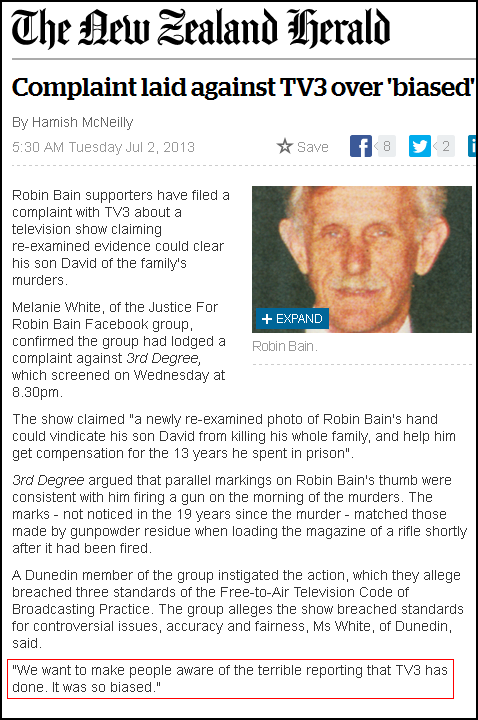.
Audrey Young on the GCSB…
.
It seems that the Herald’s Audrey Young is the only journalist in the entire country who has not bought into the Official Party Line that the GCSB Act 2003 is “vague” or “flawed”.
The GCSB Act 2003 expressly forbids it from spying on the communications of New Zealanders.
But, by a series of snakes and ladders through the stated functions and objectives of the act, it convinced itself it was allowed to help the SIS and police spy on New Zealanders.
Acknowledgement: NZ Herald – Spying on NZ: More power to watch us
She’s 100% correct of course.
The law is about as explicit as it can get, without adding crayoned drawings for the terminally dense,
.
Acknowledgement: Parliamentary Counsel Office: Government Communications Security Bureau Act 2003
.
Specifically,
Section 14 states,
Restrictions imposed on interceptions
14 Interceptions not to target domestic communications
-
Neither the Director, nor an employee of the Bureau, nor a person acting on behalf of the Bureau may authorise or take any action for the purpose of intercepting the communications of a person (not being a foreign organisation or a foreign person) who is a New Zealand citizen or a permanent resident.
Which makes other journos look lazy or incompetant or both, when they repeat government rhetoric about “vagueness” or “not fit for purpose” without checking the facts for themselves.
If Audrey Young can present the facts, then so can every other journalist worth his/her salt.
Lift your game, people.
See previous related blogpost: The GCSB law – Oh FFS!!!
.
A Tale of Two Bains…
.
The latest on the David Bain saga, and the Third Degree report on TV3 which presented damning evidence which showed Robin Bain as the most likely killer of the Bain family,
.
Acknowledgement: NZ Herald – Complaint laid against TV3 over ‘biased’ Bain report
.
Funnily enough, I cannot recall this group of obsessive-compulsives laying a similar complaint with TVNZ when Bryan Bruce (who I have much respect for, for his work on child poverty) hosted an episode on the Bain family, where he made it clear that he did not believe Robin Bain committed murder/suicide (see: The Investigator Special: The Case Against Robin Bain).
But I guess for these folk, that’s not bias, eh?
Over the years there have been many programmes presenting both sides of the case.
For one side to lay a complaint of “bias” is therefore just a little cheeky. More to the point, it illustrates a kind of growing “cult” mentality for some in the Pro-Robin/David Did It camp.
They remind me of Creationists and Climate Change Deniers.
Not healthy.
.
Old cars…
.
Something that caught my eye last week was this item in the Dominion Post,
.
Acknowledgement: Dominion Post – Ageing car fleet seen as added danger on roads
.
It occurs to me that much like trucking figures are being used as indicators of macro economic growth, our nationwide car fleet can be an indicator of the economic well-being (or otherwise) of ordinary New Zealanders at street level.
In April, John Key boasted of “strong economic growth” in 2012,
“We’re seeing some great results. We achieved 3% economic growth in New Zealand last year, which is higher than most developed countries, and business confidence is increasing. Over the weekend, I met Christine Lagarde from the International Monetary Fund while in China, who said she believes our economic plan is “very stable and it’s also very promising“.”
Acknowledgement: Scoop Media – John Key: Growing our economy
Yet, if our car fleet is getting old, and fewer are being scrapped, then that indicates that the gains are not trickling down to workers.
According to Statistics NZ,
Annual growth in the labour cost index (LCI) salary and wage rates eased for the third consecutive quarter, Statistics New Zealand said today.
-
In the year to the March 2013 quarter, salary and wage rates (including overtime) increased 1.7%. This includes a 0.4% rise in the March 2013 quarter.
-
Private sector salary and ordinary time wage rates increased 1.8% in the year to the March 2013 quarter.
-
Public sector salary and ordinary time wage rates rose 1.5% in the same period. This rise in the public sector came from increases in central government (up 1.5%) and local government (up 2.1%).
-
In the March 2013 quarter, 13% of all surveyed salary and ordinary time wage rates increased.
-
Of the 13%, the median increase was 2.4%, the lowest in 12 years.
-
56% of the surveyed sample increased in the year to the March 2013 quarter.
-
Of the 56%, the median increase was 2.9%, the lowest in 21 months.
Acknowledgement: Stats NZ – Labour Cost Index (Salary and Wage Rates): March 2013 quarter
Note the statistic buried amongst the fifures above: “In the March 2013 quarter, 13% of all surveyed salary and ordinary time wage rates increased“.
The corollary to that is that 87% had no increases to their salary and ordinary time wages.
Little wonder that our car fleet is aging. People cannot afford to buy new (or even newer second hand) vehicles.
Wherever the wealth is going, it’s not trickling down to the 87%.
So much for Key’s pledges in 2008, 2009, 2010, 2011, and 2012, to boost New Zealander’s wages. Add that one to his list of lies; broken promises, and dashed expectations.
.
.
The Price of Cocoa…
.
Three cans of cocoa tell an interesting story.
Can A is the oldest, with an expiry date of April 2011. The can measures 110mm (H) x 75mm (D). It contained 200g net dry cocoa powder.
We purchased Can B sometime in 2011 (?). The expiry date was March 2012, so it’s the second oldest can.
Interestingly, it also contained 200g net dry cocoa powder. However, whilst the contents remained the same as Can A – the dimensions of the can inexplicably increased; 130mm (H) x 75mm (D). Same diameter as Can A – but 20mm taller. Contents remain the same net weight.
.
.
A month ago we purchased Can C (expiry date, March 2015). The dimensions of this can is the same as Can B: 130mm (H) x 75mm (D). But this time, the contents decreased from 200 to 190g net dry cocoa powder. Ten grams less.
.
.
So the up-shot? The can-sizes have gotten bigger – whilst the contents has reduced by 5%.
On 9 June, I emailed Nestle to find out what was going on,
Kia ora,
It has recently come to my attention that two cans of Nestle Baking Cocoa measure 110mm X 75mm, whilst the other measures 130mm x 75mm.
Both contain 200g net cocoa powder.
The smaller can measuring 110 x 75 has a “best before” date April 2011.
The larger can, 130×75 has a “best before” date March 2012.
It appears that you have increased the SIZE of the can, whilst the contents remain the same.
Is there a reason why the size of the cans was increased, by 20mm in height?
And can you confirm that the price stayed the same; increased; or reduced; when the change was made from a 110mm height to 130mm height?
(The email was sent prior to purchasing Can C.)
Perhaps not surprisingly, I received no reply from Nestle.
Unfortunately, I never retained the receipts for Cans A and B, otherwise I could compare prices. But what’s the bet that the retail price probably increased?
So next time Dear Leader stands before the Press Gallery and claims credit for his government policies resulting in low inflation or a drop in food prices – just remember; there are lies; damned lies, Prime Ministerial utterings, and statistics.
Mix all four together and you get a “drop in inflation and food costs less”.
And thus it came to pass…
“As short a time ago as February, the Ministry of Plenty had issued a promise (a “categorical pledge” were the official words) that there would be no reduction of the chocolate ration during 1984. Actually, as Winston was aware, the chocolate ration was to be reduced from thirty grams to twenty at the end of the present week. All that was needed was to substitute for the original promise a warning that it would probably be necessary to reduce the ration at some time in April.” – George Orwell, ‘1984’
Doubleplusgood!
.
.
= fs =












Increasing the tin size is pretty cunning. Reducing the quantity has been a popular trick with manufacturers for a fair few years now. Anyone remember when a large bag of chips was 200g? Typically the price is not increased at the same time as the reduction in quantity – but give it 3 months and its fair game
A classic trick is increasing the size at the same time as the price, and then reducing the size back to the original but keeping the same price.
Comments are closed.